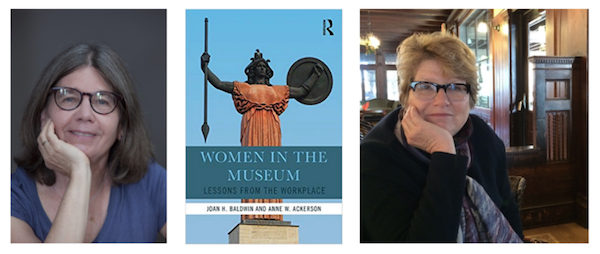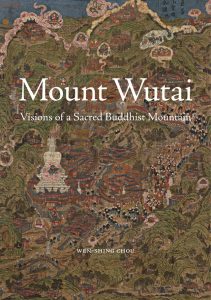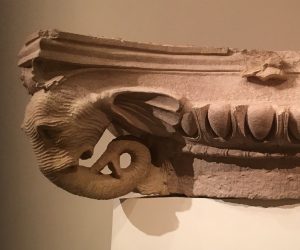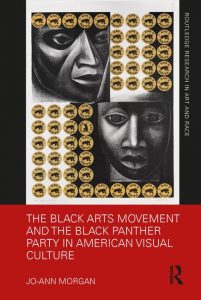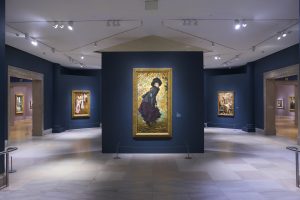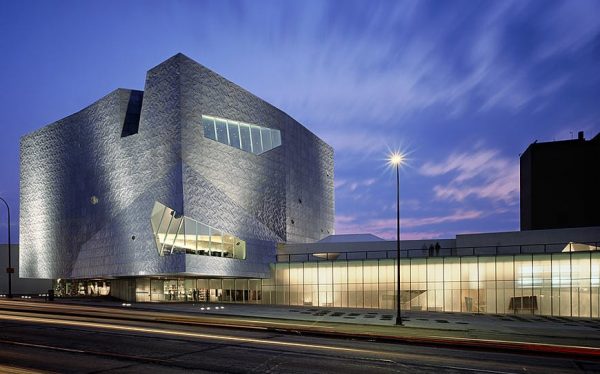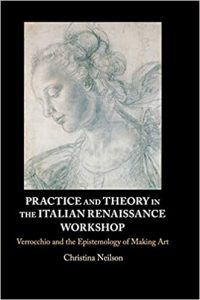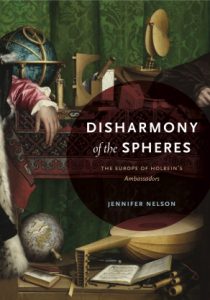CAA News Today
RAAMP Coffee Gathering: Gender Equity in the Museum (and Arts) Workplace
posted by CAA — June 30, 2020
Coffee Gathering: Gender Equity in the Museum (and Arts) Workplace
On Thursday, July 2 at 2:00 PM (EST) we will speak with Anne Ackerson and Joan Baldwin on gender equity in museums and workplaces.
To RSVP to this Coffee Gathering, please fill out this form.
A former museum director, Joan H. Baldwin is the Curator of Special Collections at The Hotchkiss School. She is the principal writer for the Leadership Matters blog which had 55,000 views in 2018. Her work has also appeared in The Museum Blog Book, “History News,” and “Museum” Magazine, Museopunks, and “The Guardian.” She is a co-founder of the Gender Equity in Museums Movement, and teaches in the Johns Hopkins University museum studies program. With Anne Ackerson, she is the co-author of Leadership Matters (2013) and Women in the Museum: Lessons from the Field (2017). She and Ackerson published a revision of Leadership Matters: Leading Museums in an Age of Discord in August 2019.
Anne W. Ackerson is a former history museum director, director of the Museum Association of New York, and director of the national Council of State Archivists. She is currently an independent consultant to cultural and educational nonprofits, specializing in leadership, governance, and management issues. With Joan H. Baldwin, she is the co-author of Leadership Matters, a book examining history museum leadership for the 21st century, and Women in the Museum: Lessons from the Workplace. She is a co-founder of the Gender Equity in Museums Movement (GEMM), which is focusing its recent efforts on education, advocacy, and policy development around pay equity, salary transparency, and sexual harassment in the museum workplace. In 2018, she and Baldwin spearheaded research, revealing that 62% of the museum workforce are affected by some form of gender discrimination. In addition to research and writing about gender inequity, she and Baldwin have presented their findings to the Texas and Pennsylvania Associations of Museums as conference keynoters and via their blog, Leadership Matters.
RAAMP Coffee Gatherings are monthly virtual chats aimed at giving participants an opportunity to informally discuss a topic that relates to their work as academic art museum professionals. Learn more here.
Submit to RAAMP
RAAMP (Resources for Academic Art Museum Professionals) aims to strengthen the educational mission of academic art museums by providing a publicly accessible repository of resources, online forums, and relevant news and information. Visit RAAMP to discover the newest resources and contribute.
RAAMP is a project of CAA with support from the Andrew W. Mellon Foundation and the Samuel H. Kress Foundation.
New in caa.reviews
posted by CAA — June 26, 2020
Lihong Liu writes about Mount Wutai: Visions of a Sacred Buddhist Mountain by Wen-shing Chou. Read the full review at caa.reviews.
Alexander Nagel considers the Metropolitan Museum of Art exhibition The World between Empires: Art and Identity in the Ancient Middle East. Read the full review at caa.reviews.
The Getty Foundation to Fund the CAA-Getty International Program for a Tenth Year
posted by CAA — June 25, 2020
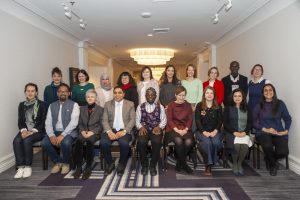
CAA-Getty Scholars at the 2020 Annual Conference in Chicago. Photo: Stacey Rupolo
The Getty Foundation has awarded CAA a grant to fund the CAA-Getty International Program for a tenth consecutive year. Unlike previous years, the 2021 program will take place virtually, due to the COVID-19 pandemic and the challenges of bringing international scholars to New York to attend the 2021 Annual Conference. CAA is especially grateful to the Getty Foundation for sustaining its support during these uncertain times, when maintaining contact with our international colleagues is more important than ever. Turning this crisis into an opportunity, the twenty participants in next year’s program will spend the time between now and February exploring the advantages of online technology for enriching scholarly research and building global bonds. Meme Omogbai, CAA’s new executive director, stated “We appreciate not only the Getty Foundation’s ongoing support, but also its faith in the CAA-Getty program to pursue scholarly excellence and innovation in an acutely challenging time. We believe the participants in this program will help lead the way for CAA’s future growth in international programs and membership.”
Over the coming months, the participants—all alumni of the program—will work in small online groups to workshop their conference papers, originally planned to be presented in person at the 2021 Annual Conference. What can be gained by geographically-distanced scholars collaborating regularly over the next six months, discussing and critiquing each other’s work? How will ideas evolve and change from early conversations to completed presentations?
The 2021 CAA-Getty program participants will also explore opportunities provided by online exchanges to produce resource materials for other scholars. Using recordings of the online discussions and the conference presentations, the group will initiate a virtual archive containing video and text documentation of the year’s work, including podcasts, bibliographies, and references related to the themes of the conference sessions. Although this virtual program breaks with the patterns established by the first nine years of the program, its forward-looking experiment in online scholarship is a fitting way to celebrate the tenth anniversary of a program that promises new models for robust scholarship in the post-COVID world.
“We applaud CAA for a taking a bold step to reimagine the international program online,” says Joan Weinstein, director of the Getty Foundation. “This thoughtful approach to digital engagement will teach us all a great deal about how to maintain international perspectives and connections in this new post-pandemic reality.”
The CAA-Getty International Program was established in 2011-12 to increase international participation in CAA and the CAA Annual Conference. The program fosters collaborations between North American art historians and curators and their international colleagues and introduces visual arts professionals to the unique environments and contexts of practices in different countries. Since the CAA-Getty International Program began, it has brought 135 first-time attendees from 49 countries to CAA’s Annual Conference. Historically, the majority of international registrants at the conference have come from Canada, the United Kingdom, and Western European countries. The CAA-Getty International Program has greatly diversified attendance, adding scholars from Central and Eastern Europe, Russia, Africa, Asia, Southeast Asia, the Caribbean, and South America. The majority of the participants teach art history, visual studies, art theory, or architectural history at the university level; others are museum curators and researchers.
About the Getty Foundation
The Getty Foundation fulfills the philanthropic mission of the Getty Trust by supporting individuals and institutions committed to advancing the greater understanding and preservation of the visual arts in Los Angeles and throughout the world. Through strategic grant initiatives, it strengthens art history as a global discipline, promotes the interdisciplinary practice of conservation, increases access to museum and archival collections, and develops current and future leaders in the visual arts. It carries out its work in collaboration with the other Getty Programs to ensure that they individually and collectively achieve maximum effect.
2021 CAA-Getty International Program Participants
Danielle Becker, Stellenbosch University, South Africa
Federico Freschi, Otago Polytechnic, New Zealand
Georgina Gluzman, University of Buenos Aires, Argentina
Richard Gregor, Trnava University, Slovenia
Alison Kearney, University of the Witwatersrand, South Africa
Sandra Krizic Roban, Institute of Art History, Croatia
Peju Layiwola, University of Lagos, Nigeria
Daniela Lucena, University of Buenos Aires, Argentina
Priya Maholay-Jaradi, National University of Singapore
Ana Mannarino, Federal University of Rio De Janeiro, Brazil
Parul Mukherji, Jawaharlal Nehru University, India
Cristian Nae, George Enescu National University of Arts, Romania
Marton Orosz, Museum of Fine Arts, Hungary
Ceren Ozpinar, University of Brighton, United Kingdom
Dasha Panaiotti, Hermitage Museum, Russia
Valeria Paz Moscoso, Universidad Católica Boliviana San Pablo, Bolivia
Judy Peter, University of Johannesburg, South Africa
Horacio Ramos Cerna, City University of New York
Nora Veszpremi, University of Birmingham, United Kingdom
Giuliana Vidarte, Pontifical Catholic University, Peru
Serve on a CAA Jury and Provide Support to the Field
posted by CAA — June 24, 2020
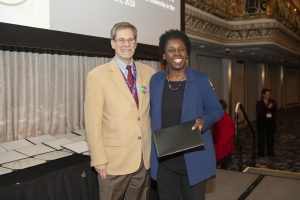
Former CAA Interim Director David Raizman and Denise Murrell, who received the Alfred H. Barr Jr. Award for Smaller Museums, Libraries, Collections, and Exhibitions for her catalog Posing Modernity: The Black Model From Manet and Matisse to Today, at the 2020 Annual Conference in Chicago. Photo: Stacey Rupolo
CAA invites nominations and self-nominations for individuals to serve on our Awards for Distinction, Publication Grant, Fellowship, and Travel Grant juries. Terms begin August 2020.
Candidates must possess expertise appropriate to the jury’s work and be current CAA members. They should not hold a position on a CAA committee or editorial board beyond May 31, 2020. CAA’s president and vice president for committees appoint jury members for service.
Awards for Distinction Juries
CAA has vacancies in ten of the fourteen juries for the annual Awards for Distinction for three years (2020–23). Terms begin in August 2020; award years are 2021–23.
- Alfred H. Barr Jr. Award for museum scholarship in the history of art/Alfred H. Barr Jr. Award for Smaller Museums, Libraries, Collections, and Exhibitions for museum scholarship in the history of art published by smaller institutions: two vacancies
- Frank Jewett Mather Award for art criticism: two vacancies
- Charles Rufus Morey Book Award for non-catalogue books in the history of art: one vacancy
- Arthur Kingsley Porter Prize for articles written by younger scholars in The Art Bulletin: one vacancy
- Artist Award for Distinguished Body of Work: two vacancies
- Distinguished Artist Award for Lifetime Achievement: one vacancy
- Distinguished Feminist Awards for Scholars and Artists: one vacancy
- Distinguished Teaching of Art History Award: one vacancy
- Excellence in Diversity Award: four vacancies
Publication Grant Juries
CAA has vacancies on our Millard Meiss Publication Fund grant jury for four years (2020–24) and the Terra Foundation for American Art Publication Grant jury for one year (2020-21).
- Millard Meiss Publication Fund: three vacancies
- Terra Foundation for American Art Publication Grant: one vacancy
Professional Development Fellowship Juries
CAA has vacancies on our Professional Development Fellowship juries for three years (2020–23). Terms begin August 2020.
- Professional Development Fellowship in Visual Arts: three vacancies
- Professional Development Fellowship in Art History: two vacancies
Travel Grant Juries
CAA has vacancies on our Art History Fund for Travel to Special Exhibitions jury for three years (2020–23). Terms begin August 2020.
- Art History Fund for Travel to Special Exhibitions: two vacancies
HOW TO APPLY
Nominations and self-nominations should include a brief statement (no more than 150 words) outlining the individual’s qualifications and experience and a CV (an abbreviated CV no more than two pages may be submitted). Please send all materials by email to Cali Buckley (cbuckley@collegeart.org), CAA grants and special programs manager; submissions must be sent as Microsoft Word or Adobe PDF attachments.
For questions about jury service and responsibilities, contact Tiffany Dugan (tdugan@collegeart.org), CAA director of programs and publications.
Deadline: July 31, 2020
In Memoriam: Cynthia Navaretta
posted by CAA — June 15, 2020
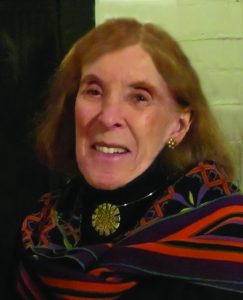
Cynthia Navaretta.
We were saddened to learn of the passing of critic, publisher, and longtime CAA member Cynthia Navaretta last month at the age of 97. An active member of the organization and a founding member of the Women’s Caucus for Art (WCA), Navaretta was founder of the feminist arts publisher Midmarch Arts Press and a tireless advocate for women artists.
A memorial in her honor will be hosted via on Sunday, September 13th, 2020, at 6pm (EST). Members interested in attending are invited to contact cyncelebration@gmail.com to receive information and a link closer to the event. Readers are also invited to post comments and pictures about her life on a newly created Facebook page, here.
Cynthia Navaretta, art critic, curator, publisher, art collector, architectural engineer died on May 18, 2020 at 97
In her mid-twenties Cynthia Navaretta was immersed in the New York art scene from the early days of the ‘New York School’ and the influential “8th Street Club” (one of only 6 female members!) before she married Emanuel Navaretta, artist, poet, critic, professor and roommate of Franz Kline in 1950. Cynthia’s friends and neighbors in New York and Long Island (Springs in the Hamptons) included Jackson Pollack, Harold Rosenberg, Lee Krasner, Milton Resnick, Milton Avery, Franz Kline, the De Kooning’s (Elaine and Willem) Ibram Lassaw, David Smith, Phillip Pavia, Judy Chicago, Agnes Martin, Pat Passlof, Hans Hofmann, June Wayne, Susan Schwalb and a long list of other art legends.
In 1974, she was a founding steering committee member of ‘Artists Talk On Art’, the art world’s longest running panel discussion series. With her knowledge of the New York art scene, along with her professional qualifications in engineering and building, Cynthia served as a mayoral appointee to the Artists Certification Committee of the NYC Department of Cultural Affairs and later served as the public voting member of the powerful Loft Board in Manhattan for 20 years, deciding who was a bona fide artist and deserving of live-work studio space in converted factories. She was a founding member of the Women’s Caucus for Art, the Coalition of Women’s Arts Organizations, and also Women in the Arts.
She represented the United States at the 1985 UN Conference on Women in Kenya and served in similar capacities on other boards and meetings around the world including the International Festival of Women Artists, Copenhagen in 1980. She befriended many well-known African-American women artists throughout the United States. In 1995, she published the first definitive compendium of American women artists of color – Gumbo Ya Ya: Anthology of Contemporary African – American Women Artists with an introduction by Leslie King Hammond, Midmarch Arts Press.
As the founder of Midmarch Arts Press, she published numerous memoirs, guides, histories and anthologies by and about American artists, male and female including: Guide to Women’s Arts Organizations, Women Artists of the World edited by Sylvia Moore, Cindy Lyle and Cynthia Navaretta, Mutiny in the Mainstream — Talk That Changed Art (with Judy Seigal), The Heart of the Question, The Writings and Paintings of Howardena Pindell, introduction by Lowery S. Sims, Voices of Women, by Lucy Lippard, Postmodern Heretics, by Eleanor Heartney, Out of the Picture: Milton Resnick and the New York School edited and with an Introduction by Goeffey Dorfman and The First Wife’s Tale: A Memoir by Louise Strauss – Ernst, to name only a few.

Cynthia Navaretta at the National Women’s Conference in Houston 1977. Credit: Judy Seigel, via The New York Times
Her sharp mind, mixed with her organizational skills and ability to span many spheres of knowledge and personalities made her the ideal art panel planner, moderator or guest speaker. She was a beloved panel participant at College Art Association and mentored many young female artists. She was an active member of the International Art Critics Association and often traveled on their numerous trips around the world. She was also the publisher, along with photographer Judy Siegel, of the well-known Women Artist News (1978 – 1991), the first publication sent out on a regular basis covering the doings and activities of women artists; thus, publishing the first constant and continuing dialogue for women artists in the United States. A prodigious publisher, author and critic of feminist art in the United States Cynthia was one of the few who acknowledged and attracted regional and southern feminist artists whose work would otherwise most probably never have seen the light of day. Through the vehicles of Women Artist News and Midmarch Press, Cynthia was determined to document and champion many obscure female artists, offering them an exclusive avenue to introduce themselves and their work to a wider audience in the art world.
In her later years, she organized and curated her archives which were accepted by the Smithsonian Institution’s Archives of American Art. This written legacy from one of the leading feminist voices on art- is sure to be preserved, shared, and seen as a unique transcript of the American art experience.
In her ‘other’ life, Cynthia earned a master’s degree in mechanical engineering the 1940s. Returning to NYC, she was hired by the construction company Alvord & Swift. Established in 1911, Alvord became a significant contractor in the emerging specialty of HVAC design and construction. She designed and built many of the HVAC systems with Alvord & Swift for well-known skyscrapers in New York, including the famous Solow building. She also designed many of the HVAC systems at the 1964 World’s Fair in New York. During her several year’s tenure there, she had the thankless job of training and preparing no fewer than three less talented male colleagues to assume the position and prestige of Vice President. This glass ceiling was the deciding factor in her eventual resignation. At that time, she was one of approximately 400 female mechanical engineers in the United States.
Throughout her engineering career, she held a variety of ambitious, supervisory positions. These included a managerial position for the ABC Television Network when the new Lincoln Center broadcast facility was being built. She also did a stint as an AMTRAK vice president, responsible for ‘new construction’ and ‘rights of way.’ She eventually retired to devote all her time to her publishing house and friends and family. But well into her nineties she could still be seen at art openings dressed to the ninths with her walker having arrived fashionably late by bus.
Remembrance by Susan Schwalb.
Join a CAA Professional Committee
posted by CAA — June 15, 2020
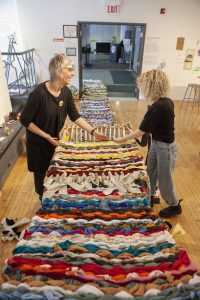
Artist Jill Odegaard (left) and participant work on Woven Welcome as part of ARTexchange at the 2020 Annual Conference, an event organized by CAA’s Services to Artists Committee. Photo: Stacey Rupolo
Call for applicants to CAA’s Professional Committees (for term 2021-2024)
The Professional Committees address critical concerns of CAA’s members. Each Professional Committee works from a charge that is put in place by the Board of Directors. Committee members serve three-year terms, with the term of service beginning and ending at the CAA Annual Conference. Candidates must be current CAA members, or be so by the start of their committee term and possess expertise appropriate to the committee’s work. All committee members volunteer their services without compensation. It is expected that once appointed to a committee, a member will attend committee meetings (including an annual business meeting at the conference), participate actively in the work of the committee, and contribute expertise to defining the current and future work of the committee. For many CAA members, service on a Professional Committee becomes a way to develop professional relationships and community outside of one’s home institution, and to contribute in meaningful ways to the pressing professional issues of our moment.
The following Professional Committee are open for terms beginning in February 2021. Please click on the links in order to review the charge of each committee, as well as the roster of current committee leadership and members:
- Committee on Design
- Committee on Diversity Practices
- Committee on Intellectual Property
- Committee on Research and Scholarship
- Committee on Women in the Arts
- Education Committee
- International Committee
- Museum Committee
- Professional Practices Committee
- Services to Artists Committee
- Services to Historians of Visual Arts Committee
- Student and Emerging Professionals Committee
Committee applications are reviewed by the current committees, as well as CAA leadership (CAA’s President, the Vice President for Committees, and Executive Director). Appointments are made by late October, prior to the Annual Conference. New members are introduced to their committees during their respective business meetings at the Annual Conference in February 2021 in New York City.
In applying to serve on a committee, applicants commit to beginning a term in February 2021, provided that they are selected for committee service.
Prospective applicants may direct logistical questions to Vanessa Jalet (vjalet@collegeart.org). Questions about the committee charge and current work to the current committee chair and/or to the Vice President of Committees: Julia Sienkewicz (julia.a.sienkewicz@gmail.com)
Self-nominations should include a brief statement (no more than 150 words) describing your qualifications and experience, combined with an abbreviated CV (no more than 2–3 pages). These two items should be forwarded in a single PDF document emailed to: vjalet@collegeart.org
Deadline for applications: Monday, August 31, 2020
Kindly enter subject line in email: 2021 Professional Committee Applicant
An Interview with Nicole Archer, Editor-in-Chief of Art Journal Open
posted by CAA — June 15, 2020
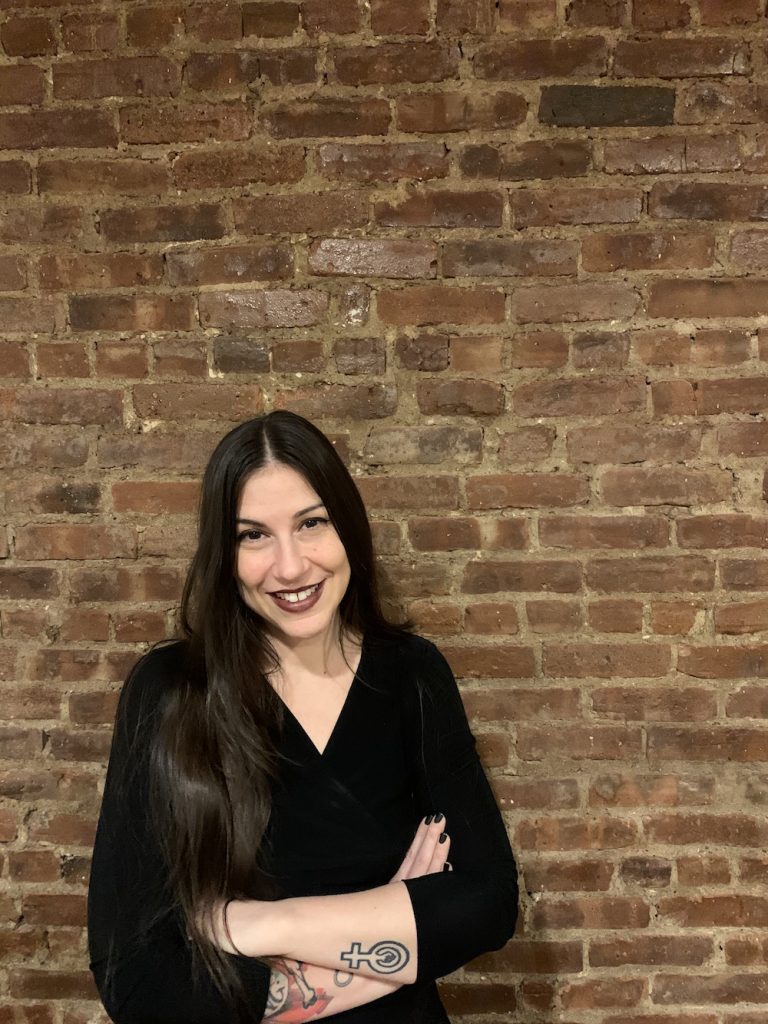
Nicole Archer.
We’re delighted to introduce readers to Nicole Archer, the current Editor-in-Chief of Art Journal Open (AJO), CAA’s online forum for the visual arts that presents artists’ projects, conversations and interviews, scholarly essays, and other forms of content from across the cultural field. Founded in 2012 as an open-access affiliate of Art Journal, Art Journal Open has been independently edited since 2014. It remains open access and is always free to explore.
Nicole Archer researches contemporary art and design, with an emphasis in textile and garment histories. She is an Assistant Professor in the Department of Art and Design at Montclair State University, where she extends this research through a teaching practice that encourages students to explore politics and aesthetics via close examinations of style, embodiment, and desire.
Amidst the end of the academic year, we corresponded with her over email to learn more about her research, her thoughts on the impact of COVID-19, and her aspirations for Art Journal Open.
Where are you from originally?
I was born in Brooklyn and raised mainly in South Florida, but I spent most of my adult life in San Francisco. In 2018, I returned to New York City.
What pathways led you to the work you do now?
My path has been shaped by a long line of committed feminist art historians, theorists, and activists who have inspired me to pursue work that is wildly curious, ethically responsible, and politically committed to issues of social justice. This, coupled with the fact that I started my college career in the mid-1990s, when the field of Visual Studies was demanding that Art History be held accountable for the role it played in supporting certain cultural hegemonies. It was a time when we were recognizing the benefit that many art historical methods could bring to critical cultural studies (and vice versa).
When did you first become a CAA member?
I have been a CAA member since 2011, but I was an avid reader of Art Journal and The Art Bulletin long before that (thanks to my library access).
What are you working on or thinking about currently?
I am currently finishing a book manuscript that considers how textiles (our key mediums of comfort and security) have been strategically manipulated over the last two decades to aid in the systematic reshaping of what constitutes “legitimate” versus “illegitimate” forms of state violence. The book tells interwoven, materially grounded stories regarding global arts and design practice, on the one hand, and military, police, and governmental action, on the other, to theorize how feelings of insecurity are produced, aesthetically.
What are your thoughts on the impact of COVID-19 on the work you do? On the field?
I think the current pandemic makes two things particularly clear. First, it highlights the important role that art and design can play in helping a society understand (and bear) emergent and acutely difficult circumstances. From movie marathons, artist talks, and book readings that we have enjoyed during our nights spent ‘sheltering in place,’ to the protest banners, photographs, and balcony performances that have led our communities towards acts of collective care and solidarity with one another.
Second, COVID-19 puts the varied inequities that underwrite the field in high relief. It makes the economic precarity of so many cultural workers glaringly obvious, and it forces us to recognize how undervalued cultural work actually is. We need to ask why we have allowed the arts to become so defunded and privatized (despite the social value it clearly delivers). Calls for austerity are circulating, and we know this means further cuts to already underfunded public arts initiatives. We need to resist this and seize this moment as an opportunity to insist on our value. We need to stop undercutting ourselves and our peers, and refuse to accept the exploitation of adjunct professors and graduate student teachers. We must do this as we push against the increasingly prohibitive costs of arts education.
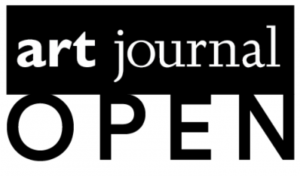 What led you to be interested in working on Art Journal Open?
What led you to be interested in working on Art Journal Open?
It is our shared responsibility, as arts and design professionals, to constantly “check” our field of practice—to find time to celebrate what we are doing well, and to redress and learn from our shortcomings. I believe this responsibility is a cornerstone of AJO’s editorial mission. Working on AJO is a unique opportunity to hold myself, and others, accountable on this front.
What is your vision for Art Journal Open during your tenure?
I hope to build on the solid foundation laid by the journal’s previous editors, and to further emphasize the open dimension of the publication’s identity—to treat “Open” as a verb, a call to action. We hope to accomplish this by leveraging the journal’s digital format, to open space for more multi-media Creative Projects, and to take advantage of our lack-of-paywall to help draw new readers to AJO and new voices to CAA.
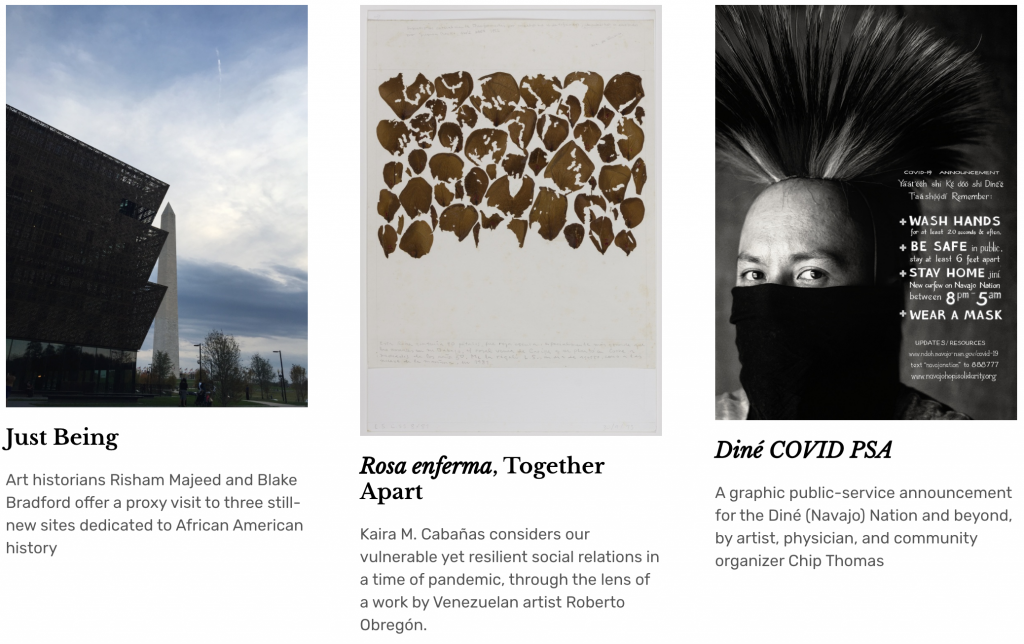
The first three pieces published after Nicole Archer fully took over as Editor-in-Chief of Art Journal Open.
What would you say is your top arts-related recommendation (book, website, resource) at the moment?
I know I am late to this, but I recently found an online radio station called NTS and it is giving me life! I miss trusting my night to a DJ, hearing a new song out of nowhere, and dancing with strangers. I am also tired of soundscapes controlled by algorithms. People should give it a listen in their studios and kitchens, and at their computers and writing desks.
View this post on Instagram
A favorite artwork?
Last year, I had the opportunity to see Sonya Clark’s Monumental Cloth, The Flag We Should Know at the Fabric Workshop and Museum in Philadelphia, and I have not been able to stop thinking about it since. Clark’s work epitomizes the important role art can play in ensuring that political discourse maintains its complexity in the face of a mediascape set on transforming these conversations into flat lines in the sand.
At the center of the exhibit was a monumental replica (15’x30’) of a white dish towel waived by Confederate troops in April 1865, before General E. Lee negotiated the terms of the Confederacy’s surrender. Displayed in a manner akin to the Star Spangled Banner (a centerpiece of the Smithsonian National Museum of American History’s collection), Monumental Cloth presented the Confederate Truce Flag as testament to a decisive moment in US history. It demanded that we ask why we do not know this flag, as a means to discuss anti-Blackness and the persistence of white supremacy in the United States. It provided a poignant, aesthetic counterstrategy to other manners of “memorializing” the Confederacy. The exhibit offered spaces of contemplation alongside opportunities for direct action—by setting-up looms that visitors could use to weave additional Truce Flag replicas, in opposition to the endless flow of commercially produced items made to bear the image of the Confederate Battle Flag.
What are you looking forward to?
Honestly, I am looking forward to the end of the Trump presidency, and to the possibility that the moment we are in could force real political and cultural change; that conversations around universal basic income and healthcare will gain traction, and that widespread recognition of the systemic racism inherent in the criminal justice system will open the door to both abolishing the prison system and defunding and demilitarizing the police that tyrannize communities of color in the US.
NICOLE ARCHER BIOGRAPHY
Nicole Archer researches contemporary art and design, with an emphasis in textile and garment histories. She is an Assistant Professor in the Department of Art and Design at Montclair State University, where she extends this research through a teaching practice that encourages students to explore politics and aesthetics via close examinations of style, embodiment, and desire.
Her work has been published in various journals, edited collections, and arts publications, including: Criticism: A Quarterly Journal for Literature and the Arts; Textile: The Journal of Cloth and Culture; Trap Door: Trans Cultural Production and the Politics of Visibility (published by the New Museum + MIT Press); Where are the Tiny Revolts? (published by the CCA Wattis Institute for Contemporary Arts + Sternberg Press); Women and Performance: A Journal of Feminist Theory.
New in caa.reviews
posted by CAA — June 12, 2020
Komozi Woodard reviews The Black Arts Movement and the Black Panther Party in American Visual Culture by Jo-Ann Morgan. Read the full review at caa.reviews.
Imogen Hart discusses the exhibition and catalog James Tissot: Fashion & Faith, Legion of Honor, San Francisco. Read the full review at caa.reviews.
News from the Art and Academic Worlds
posted by CAA — June 10, 2020
|
|
|
|
|
Want articles like these in your inbox? Sign up for our weekly newsletter:
New in caa.reviews
posted by CAA — June 05, 2020
Elizabeth Petersen Cyron writes about Christina Neilson’s Practice and Theory in the Italian Renaissance Workshop: Verrocchio and the Epistemology of Making Art. Read the full review at caa.reviews.
Michael Gaudio reviews Disharmony of the Spheres: The Europe of Holbein’s “Ambassadors” by Jennifer Nelson. Read the full review at caa.reviews.



